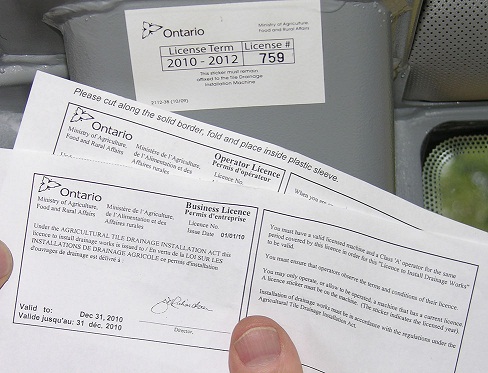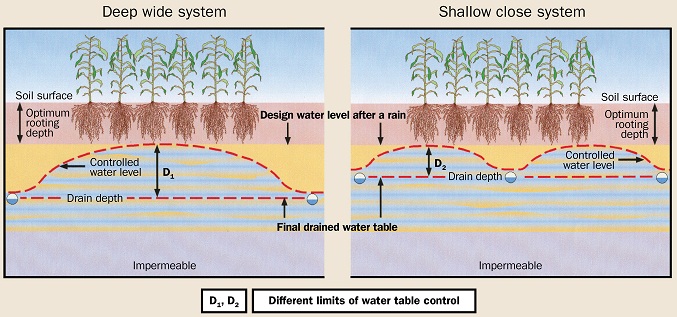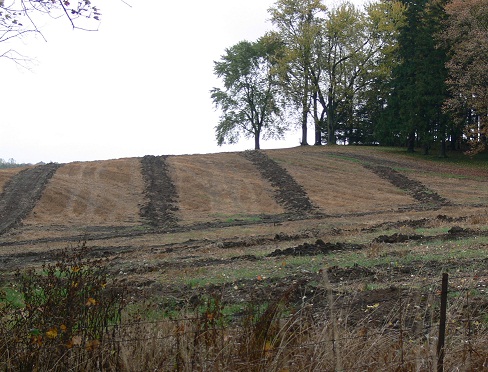Considerations when planning to drain land
Learn how to get the most value from an investment in land drainage. This technical information is for agricultural property owners.
ISSN 1198-712X, Published December 2024
Introduction
With proper care, well-drained soil increases the opportunity to produce sustained high yields with a variety of crops. This fact sheet contains information on getting the most value from an investment in land drainage.
For a subsurface drainage system to work effectively, it must be carefully and accurately designed and installed. Consider hiring a licensed contractor to plan and install the drainage system. Contractors can advise if they are able to plan the drain layout or if the services of a professional engineer are required.
Drainage contractors are professionals with a lot of experience designing and installing drainage systems in a variety of soils and situations. They have specialized training and the right equipment to properly install drainage systems at the required depth and grade. They understand how soils will respond to subsurface drainage. They know the environmental regulations, including where system outlets can be legally installed. Schedule the drainage project well in advance to ensure the contractor is available when needed.
In Ontario, the Agricultural Tile Drainage Installation Act, 1990, regulates the installation of agricultural tile drainage systems. Anyone other than the landowner doing the work on the farm must be licensed by the Ministry of Agriculture, Food and Agribusiness (OMAFA).
It is important to ensure the contractor hired has the required licences (Figure 1) under the Agricultural Tile Drainage Installation Act, 1990. Landowners should ask the contractor and their employees to present hard copies of their licences (business, machine and operators), prior to the contractor starting any work. The contractor should also have the appropriate level of liability insurance.
Review the OMAFA fact sheet, Agricultural drainage licensing, for further information.

Before construction
Have the soil examined by a licensed contractor. Not all soils respond favourably to subsurface drainage. Verify whether installing a system is a good investment for the farm.
The very first thing to do when installing a new system or adding to the existing drainage system is to make a plan. The plan should contain detailed information for the entire farm, even if only a portion of the farm will be drained. If there is an existing drainage system, the existing drainage plan is also required. During planning, consider the drainage that occurs from upslope watersheds or neighbouring farms.
If planning a major field enlargement, keep 2 factors in mind:
- Large fields, although convenient for machinery, seldom dry evenly.
- Long slopes on large fields create very difficult erosion problems even if there is minimal grade.
A key consideration for every drainage system is the outlet used to discharge the collected water. Ensure you have the legal right to use the outlet before starting any planning or work. Also confirm the outlet can handle the amount of water to discharge. There are several options to consider when looking for an outlet:
- Determine if there is an existing outlet on the property. This includes a natural watercourse, an existing municipal drain or a mutual agreement drain.
- If there is currently no outlet available, consider negotiating an agreement (a written agreement is recommended) with neighbours to get access to an outlet on or across their property.
- If this is not possible, consider petitioning the local municipality for a municipal drain under the Drainage Act, 1990.
It is best if the system is designed with as few outfalls as possible to minimize time and cost spent on future maintenance.
Review the OMAFA fact sheets, Drainage legislation and common law in Ontario and Mutual agreement drains, for further information.
Making a plan before the work begins is essential. Provide the contractor with a copy of the existing drainage plan (if available) or show the contractor the field and provide as much information as possible about the system. Discuss what the contractor will do about inspecting the existing/older system and connecting it to the new system.
Ensure the contractor is aware of all utilities and easements that exist on and near the farm – call Ontario One-Call first to get the required locates. Confirm the contractor is aware of locations of manure storages and the Nutrient Management Act, 2002, requirements for separation distances for the farm.
Ensure the contractor is aware of the cropping practices and schedule carried out on the farm. It is best to design the system with the lateral drains running perpendicular or skewed to the way the field is worked, otherwise dead furrows will not drain well.
Lateral depth and spacing are interconnected and should be determined together. In general, deep drains with wide spacing give similar results to shallow drains with narrower spacing as shown in Figure 2. Refer to Publication 29: Drainage Guide for Ontario for depth and spacing recommendations for a variety of Ontario soils.

The contractor should use the proper size main drain. Locate the main drain away from the headland area where it is subject to loads from heavy equipment. Locate main drains far from trees and hedge rows to reduce the risk of blockage caused by invasive tree roots.
Environmental considerations could affect the design and installation of the system. It is important to check with the local conservation authority to see if there are any regulatory requirements related to timing of the work, floodplain issues or source water protection requirements. If connecting to a municipal drain, contact the local municipality to ensure that all of its requirements are met.
Ensure the contractor has cleared the design of the system with the landowner before any work starts.
Decide in advance with the contractor where the material (pipe, fittings) will be delivered to the site, where it will be stored and for how long. Pipe covered with envelope material deteriorates with exposure to sunlight and should not be stored outside too long. Get the drain pipe ordered and delivered well in advance of the job. An early order may get a discount, but more importantly, it provides a chance to examine the shipment and its quality.
Negotiate the final cost estimate for the project and discuss the payment details with the contractor before the work begins. Arrange for financing for the project – consider accessing the Tile Loan Program if necessary. Review the OMAFA fact sheet, Tile Loan Program, for further information.
Confirm the proposed installation schedule is compatible with the cropping schedule. If possible, plan to have the field in wheat stubble or hay for the installation. If it is necessary to install through crops, try to have minimal crop damage.
To avoid the risk of soil compaction, install the system in summer or later fall (between June 15 and November 15) when the soil is reasonably dry. If the soil is dry enough to work, it is dry enough to install subsurface drains.
During construction
Keep an eye on the work as it progresses to ensure that it is going according to the plan. Make notes of any locations or issues where the contractor seems to run into problems during the job. If a major technical challenge develops that cannot be resolved with the contractor, contact the provincial drainage inspector immediately.
If an existing drainage system is present on the land, ask the contractor what its condition is like and if it can be connected to the new system. Drain pipe in the ground with no outlet is worse than no drainage at all. It may cause wet spots to develop in the low spots of the field. If older drains are clean (free of sediment and tree roots), connect them to the new system by laying them parallel or by backfilling with gravel. These types of connections do not risk damaging the new system.
You should be satisfied with the job before the contractor leaves the site. Use the following questions as a guide:
- Are the drains installed as per the plan?
- Was the overall job and workmanship satisfactory?
- Who is responsible for site clean-up?
- Usually, the landowner is responsible for site clean-up and restoration. If the contractor has agreed to perform this work, has it been done satisfactorily?
- If not, spread any surplus soil over the surrounding field, remove materials such as large stones and roots from the worksite, pickup any unused, broken or cut drain pipe, and repair/replace fencing.
- Did the contractor provide an "as-built" drainage plan?
- Will the same contractor complete future drainage work?
- Inform the contractor of future drainage plans.
- Try to arrange future work as early as possible to ensure the contractor is available when needed.
After construction
Ensure your contractor has prepared a proper "as-built" drainage plan of the system and provided a copy for future reference. If the contractor uses a GPS control system, request a copy of the GPS data files. Keep this information with the property deed, so even if the property ownership changes, the drainage information is kept with the farm. Some municipalities require or allow for storage of the drainage plan at their office. This creates a permanent record, which helps locate the drains for future subsurface drainage repair or improvements.
A good drainage plan includes the following:
- date of construction
- name of installer (contractor or landowner)
- identification of any changes made during installation from the original plan
- lateral spacing, size, depth, grade, footage and material
- main location, material, size, depth, grade and capacity
- details of any construction problems encountered during the installation
- location of all outfalls, surface water inlets and other structures
- location of utilities, sand pockets and springs that may affect future maintenance
If a formal plan has not been provided by the contractor or if the landowner does the installation, a simple pencil sketch that provides the same information is acceptable. In the absence of a proper plan, obtain an aerial photograph of the work area to show the drainage system.
Using the drainage plan as a guide, locate and mark all outfalls and surface water inlets if not already marked by the contractor. If possible, note the GPS coordinates using a handheld GPS device so you can locate the outfalls, surface water inlets and other structures in the future.
It is also important to keep a copy of any drainage reports and plans made under the Drainage Act, 1990 and all records for any mutual agreement drains.
What happens during the initial period following the installation of the new subsurface drainage system is critical to ensuring it functions properly for years to come. The soil around and above the drains will still be loose and should be left alone to settle naturally with time and rain (Figure 3). Do not use equipment to pack down the soil over the drains, as any heavy pressure on the loose soil could damage or collapse the pipes. Minimize traffic on the field for as long as possible, and straddle the tile runs with equipment or work across (not parallel to) the drains when working the field in the first year after installation.

The efficiency of the drainage system is highly dependent on the soil. In some soils, the drainage improvements are immediate and continue at that level for many years. In other soils, the drainage will improve immediately, slow down over several years as the soil consolidates, then slowly improve. In many clay soils, the drainage develops more slowly as the soil opens up. Planting deep-rooted crops improves the soil structure and creates water passages overtime.
Make sure all surface water inlets are fitted with a proper guard or grate to keep debris and trash out of the subsurface drainage system.
Ensure a grate or rodent guard is installed on all outfall pipes to prevent unwanted entry by burrowing animals such as rodents, muskrats, rabbits and foxes.
There is no better way to protect your investment than with regular and proper inspection and maintenance of your system. Even a well-constructed system built to last a lifetime must be carefully maintained. Further information on the maintenance of a drainage system is found in the OMAFA fact sheet, Maintenance of a subsurface drainage system.
Complementary practices
Use good soil management and other complementary practices to enhance and develop the performance of the drainage system. Best practices include the addition of organic matter, reducing organic matter loss, improving the soil structure and porosity, and reducing the risk of compaction.
The objective of good soil management is to keep damage to the soil structure to a minimum. It is not advisable to overwork the soil. If the surface is worked too fine, it may puddle and not allow water to infiltrate into the subsoil and drainage system. Do not work the soil when it is wet, as it will compact, reducing the flow of water to the drainage system.
It is best if the fields are tilled either perpendicular or skewed to the direction of the lateral drains. This practice helps minimize any crushing of the drain pipe and ensure its long-term integrity. It also helps ensure more uniform drying across the field and avoid dead furrows that do not drain well.
Crop rotations and methods of cultivation that maintain a good soil structure help keep drains working well, especially in heavy clay soils. Growing deep-rooted legumes such as alfalfa or sweet clover also improves drainage.
Always use a good surface drainage system with every subsurface drainage system. Do not abandon the surface system. They work well together.
Author credit
This fact sheet was written by Tim Brook, P. Eng., drainage program coordinator, OMAFA. It was reviewed by Andy Kester, drainage analyst/inspector, OMAFA and Amber Langmuir, P. Eng., water management engineering specialist, OMAFA.